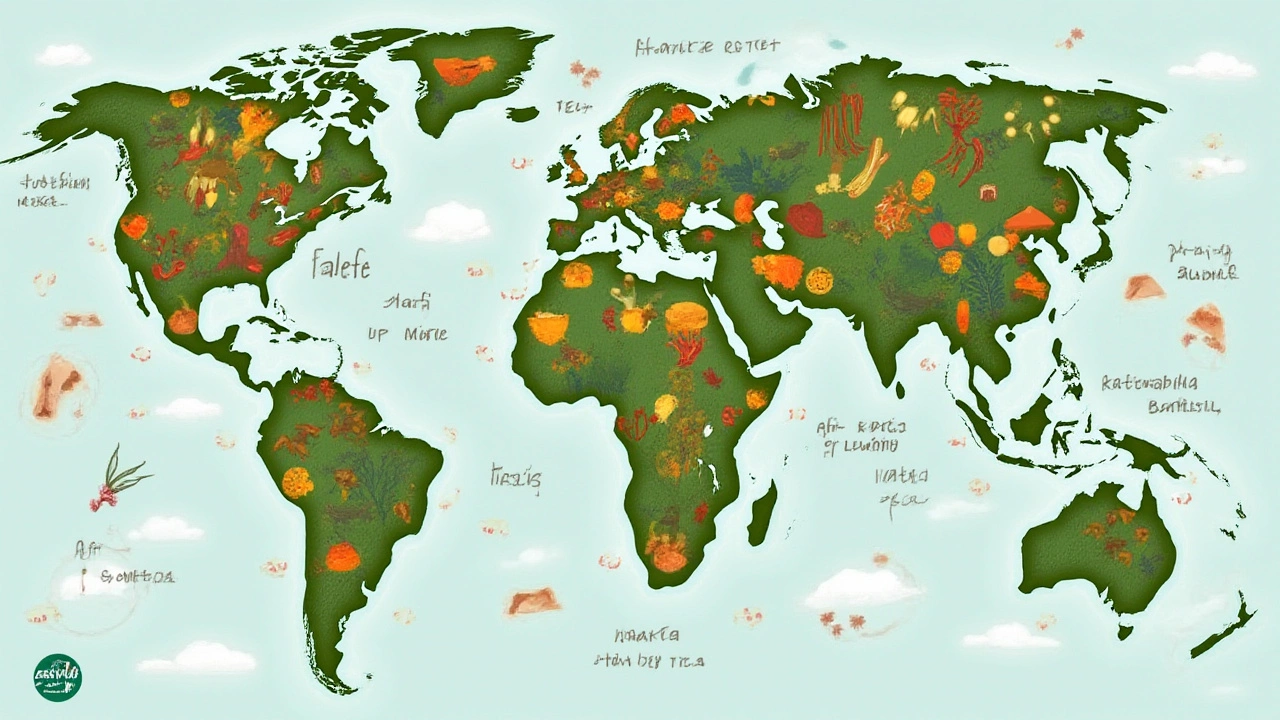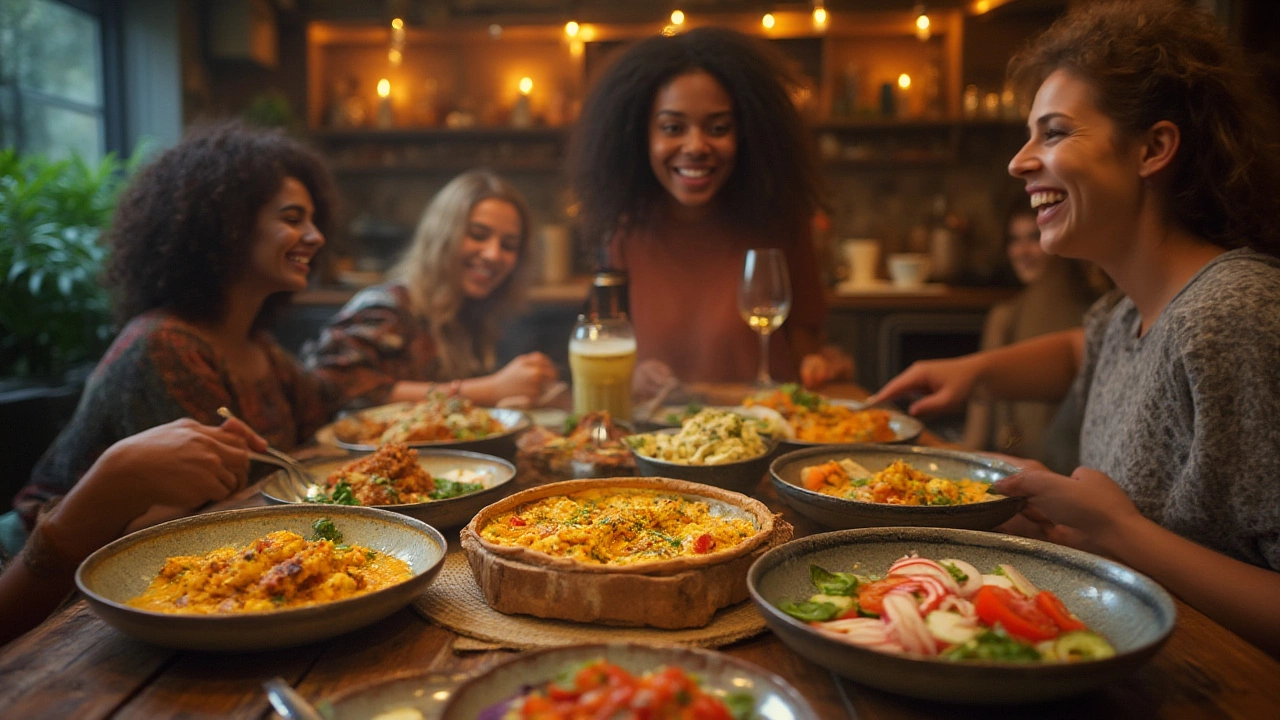Imagine a world where choosing what to eat as a vegetarian isn't about compromise—it's about discovering something new, flavorful, and genuinely mouthwatering at every meal. Going meatless doesn't mean you have to settle for bland side salads or tired pasta dishes. In fact, some cuisines practically roll out a red carpet for plant-based eaters, and that's where things get interesting. Most people don't realize that certain cultures have been perfecting vegetarian food long before it was Instagram cool or called "plant-based." Whether you're a lifelong veggie or just bored of the same old stir fry, there's a whole globe of vegetarian delights waiting to be explored. Ready for a culinary tour where vegetables don’t play second fiddle? Plates in hand, let's get moving.
Why Some Cuisines Stand Out for Vegetarians
Certain national or regional diets roll off the tongue when anyone mentions vegetarian-friendly food, and that’s not just because they like a spotlight. Huge swathes of India—over a third of its population, according to a 2024 Pew Research survey—identify as vegetarian. That's more plant-focused eaters than the entire population of Mexico. The traditions here go way back: think centuries-old temple food, family recipes passed down for generations, and vibrant markets selling spices you probably can’t pronounce. Curry houses in Gujarat, dosa joints in Tamil Nadu, and Punjabi dhabas—these places don’t just have vegetarian options; they are vegetarian by design. Paneer tikka, chana masala, saag aloo—hungry yet?
Mediterranean cuisine is next-level good for anyone swearing off meat. In Greece, you’re served up tangy feta, lush olives, and stews packed with lentils, tomatoes, and silky eggplant. Think Turkish mezze tables, where a spread of small plates—hummus, dolmas, roasted veggies—could keep you grazing for hours. And Italy, well, let’s not pretend it’s only about pizza. True, the Margherita is basically a meatless icon, but what about minestrone soup, risotto primavera, and eggplant parm? The magic of Mediterranean food is that veggies are center stage because of tradition, not trend. Countries that border the sea have been living the plant-based life for centuries, long before phrases like "Meatless Monday" took off.
Let’s not forget East Asian cuisine, either. In Vietnam, vegetarianism goes hand-in-hand with Buddhist customs, especially during full moons and new moons—times when tons of restaurants flip their menus to completely meat-free. Tofu isn’t just a substitute in China; it’s a star. Dishes like mapo tofu, Buddha’s delight, and zesty stir-fried greens can hold their own against anything carnivores are eating. Japan’s Buddhist shojin ryori—served in temples—is a wholly plant-powered experience, with meals built from tofu, seaweed, seasonal veggies, and grains. In Thailand, flavor isn't sacrificed for meatlessness. Herbs, coconut milk, and chili make veggie curries that hit you with enough taste to forget you ever loved chicken satay.
So, why do these cuisines rise above the rest for vegetarians? Culture and faith have a lot to do with it, but so does geography. Areas where meat was historically scarce often made vegetables, grains, and legumes the main event. And the result? A treasure trove of flavors, cooking methods, and tricks for coaxing out richness and depth minus any steak or drumstick.

Essential Cuisines Every Vegetarian Should Try
If you’re serious about living your best vegetarian life, there are a few global cuisines you just can’t skip. Let’s break them down, so next time you walk into a restaurant or scroll through a delivery app, you know exactly what to look for.
Indian cuisine is the undefeated heavyweight champion of vegetarian food. From North to South, the menu is bursting with options thanks to a roster of lentils, pulses, dairy, and an encyclopedia of spices. Dal makhani, palak paneer, baingan bharta, idli with coconut chutney—every region brings something solid. Street food isn’t off-limits either; potato-filled samosas, pav bhaji, and bhel puri are all vegetarian classics.
| Country | % of Vegetarians | Common Vegetarian Dishes |
|---|---|---|
| India | 39% | Dal, Paneer Tikka, Aloo Gobi |
| Italy | 10% | Caprese Salad, Pasta Primavera, Eggplant Parmesan |
| Israel | 13% | Falafel, Shakshuka, Sabich |
| Vietnam | 8% | Goi Cuon, Pho Chay, Stir-fried Tofu |
| Thailand | 9% | Pad Thai Jay, Green Curry, Som Tum (without fish sauce) |
Middle Eastern food is a plant-eater’s dream. Falafel—crunchy on the outside, fluffy inside—started off as street food and became an international superstar. Mezze spreads with baba ghanoush, tabouleh, and mujadara are completely vegetarian and packed with herbs, grains, and legumes. Don’t sleep on the Persian food scene, either: sabzi polo (herbed rice), kashk-e bademjan (eggplant dip), and kuku sabzi (herb frittata) all prove that flavor doesn’t need meat.
Mediterranean cooking is another gold mine. Greek spanakopita, Italian caprese salad, and Provençal ratatouille are all iconic dishes made for vegetarians. Lots of people think Mediterranean diets are all about grilled fish and chicken, but the real stars are fresh tomatoes, zucchini, artichokes, peppers, chickpeas, and plenty of bread and olive oil.
East Asian food brings a different set of flavors. Buddhist traditions in China and Japan have inspired tons of fully plant-based meals. Dishes like miso soup, vegetable sushi rolls, and tofu stir-fry pack in protein and flavor. If you’re looking for umami—the mouthwatering fifth taste—without meat, try shiitake mushrooms, fermented bean pastes, or kombu (seaweed). In Korea, banchan (side dishes) like kimchi, pickled radish, and sautéed greens mean a vegetarian plate is never boring. Japchae—sweet potato noodles thrown in with stir-fried veggies—makes a filling, satisfying dinner, and bibimbap can stay meat-free if you top it with tofu and drop the beef.
Latin American cuisine can be tricky, but Argentina and Brazil are not the whole continent. Mexican food, for example, is hugely vegetarian-friendly. Black bean tacos, chiles rellenos, nopales (cactus), elote (street corn)—it’s easy to skip the carnitas and still eat well. Peru gives you causa (potato cakes), papa a la huancaína (potatoes in a creamy, spicy sauce), and fresh ceviche de champiñones using mushrooms instead of fish. In the Caribbean, stewed red beans, rice and peas, fried plantains, and veggie curries fill you up and make you wish you’d found them sooner.
What about continental Europe? France is not a vegetarian stronghold, but Provençal vegetable tarts, ratatouille, and salad Nicoise (minus tuna) work in a pinch. German-speaking countries are getting the message lately—Berlin’s vegan scene is booming, and even classic Bavarian pretzels or käsespätzle (cheese noodles) hit the spot for meatless eaters.

Smart Tips, Surprising Facts, and Next-Level Ideas for Vegetarian Cuisine
Staying satisfied as a vegetarian can sometimes feel like a logistical puzzle, especially if you’re cooking at home or traveling. But learning a few kitchen hacks or menu tricks can turn boring into brilliant.
First off, flavor is everything. No one wants to eat plain steamed broccoli every night. Layer seasonings: herbs, lemon juice, garlic, and international spice blends can give life to any vegetable or grain. Za’atar on roasted eggplant wakes things up; garam masala in your chickpeas is a game changer. Always keep a batch of homemade pesto or muhammara (red pepper dip) in the fridge—smear it on sandwiches or toss with pasta for an instant upgrade.
Balance is key—don’t just swap meat for more cheese or bread or you’ll miss out on nutrients and get bored fast. Think variety. Include protein-rich foods like lentils, chickpeas, tofu, tempeh, and nuts. Quinoa and buckwheat are easy substitutes for rice and bring extra nutrients.
Shopping in specialty grocery stores is a secret weapon. Middle Eastern, Indian, Asian supermarkets are full of exciting ingredients—paneer, jackfruit, miso, tahini, dried mushrooms—that are the backbone of vegetarian cooking across the world.
If you’re traveling, learn the basics. In Thailand, ask for “jay” food—restaurants labeled jay follow vegan Buddhist rules and don’t use fish sauce, eggs, or dairy. In Mexico, “sin carne” means no meat, but keep an eye on lard (called manteca) in tortillas or beans. In France or Italy, don’t be shy—ask for vegetables cooked “grillé” or “a la plancha.” Know how to say “I don’t eat meat” in the local language, and keep a few tried-and-true vegetarian snacks handy just in case.
Meal prepping helps: Mediterranean-inspired salads, Indian dal, and homemade hummus all stay fresh for days. Roast extra vegetables on Sundays and use them in grain bowls, tacos, or wraps. Freeze leftover soups and curries for quick lunches.
Ever walked into a restaurant and scanned the menu in desperation? Skip meat replacements if you can and go straight for food that’s vegetarian by design. Think Turkish mercimek köftesi (lentil balls), Ethiopian miser wot (spicy lentils), or Japanese kinpira gobo (braised burdock root and carrot). They’re packed with flavor and don’t taste like a knockoff of something else.
Get creative at home: swap out pizza crust for cauliflower, use lentil or chickpea flour in crepes or pancakes, and turn leftover veggies into fritters. Make the most out of simple foods—try smashed avocado with lime and chili on toast, or breakfast grain bowls with roasted sweet potato, black beans, and salsa. The possibilities with vegetarian cuisine are way bigger and tastier than most people think.
One thing’s crystal clear: the best cuisine for vegetarians isn’t defined by any one country—great plant-based food is found wherever people have learned to celebrate vegetables, grains, and pulses for their own natural flavors and textures. Don’t be afraid to experiment, try something new, and just enjoy every bite.

